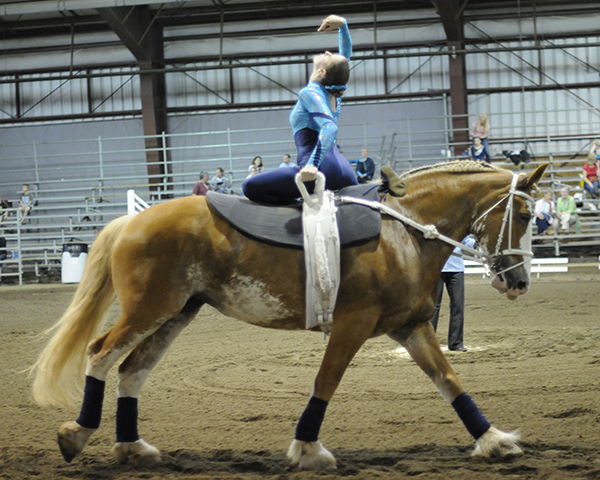- Me
- Gallery
- Info
- Get Started
- About Vaulting
- Find a Club
- Everyone
- News & Notices
- Rules & Resources
- Committees on Trello
- Coaches & Officials
- Certification
- Updating
- More
- Contacts List
- Useful Links
- Word Cloud
- Events
- Your Province
- Video
If the answer to a question you are looking for is not here, please let us know at [email protected] !
 Why Vault?
Why Vault?Vaulting is an affordable way to become involved with horses. Vaulting develops co-ordination, flexibility, strength, balance, creativity, and harmony with the horse. Vaulting teaches responsibility, trust and self-confidence, and is an excellent introduction to horses and equestrian sport in a safe, structured environment. Vaulting has a long tradition of teamwork and camaraderie that crosses boundaries of clubs, countries and even continents.
People have been performing acrobatic and dance-like movements on the backs of moving horses for more than 2,000 years. Stone paintings, which date back to the Pre-Romanic Ice Period, depict horses with persons standing on them. In the Classical Olympics in Greece “Artistic Riding” was part of the competitions. Modern vaulting was developed in postwar Germany as a way to introduce children to equestrian sports. In 1983 vaulting became one of the seven equestrian disciplines recognized by the FEI (Federation Equestre Internationale).
Many different sizes and breeds of horses are used for vaulting. The best vaulting horses are kind, calm, and people oriented. Vaulting horses are carefully trained to perform at a consistent gait, and to become comfortable with vaulters performing a variety of movements. Vaulting horses are generally a happy bunch due to the love and attention they receive from their vaulters.
Vaulting can be done recreationally, competitively, therapeutically, or as a combination of all three. On average, Canadian vaulting clubs attend two or three vaulting competitions per year. The majority of competitions cater to all levels of vaulters, which allows athletes to be exposed to all levels of vaulting from the very beginning of their competitive careers. The peak competitive level of vaulting competitions would be FEI World Championships or FEI World Cup Finals which are held annually.
Lesson structure is individual to each club and coach, but most lessons with include: horse care, grooming, tacking up, vaulter warm up, barrel training, and horse training. A typical beginner class with have students sharing one horse, with a lunger and coaches assisting and supervising activities.
Vaulting is a very safe introduction to equestrian sports, as the vaulter is not the sole person responsible for communication with the horse. This means that vaulters can learn how to control their own bodies, move safely, and dismount the horse while the lunger and horse work together to maintain a safe environment. Clubs associated with Provincial Vaulting Organizations are required to have trained and certified coaches who plan and oversee all lessons.
For a number of reasons, helmets become a safety hazard instead of a safety precaution. You can learn more about this on our Helmets and Vaulting page.
No! Vaulting is a very inclusive sport, and you will learn everything you need to know about horses and vaulting within lessons.
Compared to other equestrian disciplines, vaulting is generally less expensive as vaulters share a horse, and do not need to purchase or lease their own.
Vaulters can practice in any athletic pants that allow them to move comfortably. Beginner vaulters generally wear water shoes, which can be purchased easily at many different locations. As vaulters move up the levels they may need to purchase vaulting shoes, which can be ordered online, and range from $50-$150.
Generally, clubs accept vaulters as young as 4 or 5 years old. Vaulting has no age cap, and can be enjoyed by adults of all ages.